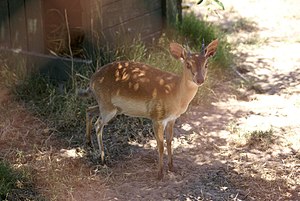
The lion is a large cat of the genus Panthera native to Africa and India. It has a muscular, broad-chested body, short, rounded head, round ears, and a hairy tuft at the end of its tail. It is sexually dimorphic; adult male lions are larger than females and have a prominent mane. It is a social species, forming groups called prides. A lion's pride consists of a few adult males, related females, and cubs. Groups of female lions usually hunt together, preying mostly on large ungulates. The lion is an apex and keystone predator; although some lions scavenge when opportunities occur and have been known to hunt humans, the species typically does not actively seek out and prey on humans.

Twycross Zoo is a medium to large zoo near Norton Juxta Twycross, Leicestershire. The zoo has the largest collection of monkeys and apes in the Western World, and in 2006 re-launched itself as "Twycross Zoo – The World Primate Centre".
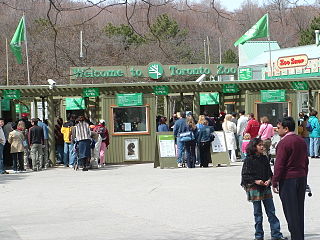
The Toronto Zoo is a zoo located in Toronto, Ontario, Canada. Encompassing 287 hectares, the Toronto Zoo is the largest zoo in Canada. It is divided into seven zoogeographic regions: Indo-Malaya, Africa, Americas, Tundra Trek, Australasia, Eurasia, and the Canadian Domain. Some animals are displayed indoors in pavilions and outdoors in what would be their naturalistic environments, with viewing at many levels. It also has areas such as the Kids Zoo, Waterside Theatre, and Splash Island. It has one of the most taxonomically diverse collection of animals on display of any zoo worldwide; it is currently home to over 5,000 animals representing over 500 species. The zoo is open to the public every day of the year except December 25.
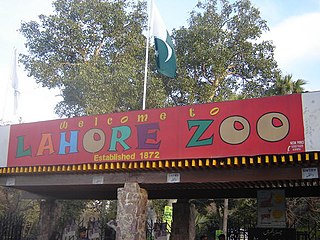
Lahore Zoo in Lahore, Punjab, Pakistan, established in 1872, one of the largest zoos in Pakistan. It is currently managed by the Forest, Wildlife and Fisheries department of the Government of Pakistan. Today the zoo houses a collection of about 1378 animals of 135 species. Lahore Zoo was the host of the fifth annual conference of SAZARC in 2004.

Copenhagen Zoo is a zoological garden in Copenhagen, Denmark. Founded in 1859, it is one of the oldest zoos in Europe and is a member of EAZA. It comprises 11 hectares and is located in the municipality of Frederiksberg, sandwiched between the parks of Frederiksberg Gardens and Søndermarken. With 1,571,331 visitors in 2019 it is the most visited zoo and one of the most visited attractions in Denmark. The zoo is noted for its new Elephant House designed by British architect Sir Norman Foster. The zoo maintains and promotes a number of European breeding programmes.

The Los Angeles Zoo and Botanical Gardens is a 133-acre (54 ha) zoo founded in 1966 and located in Los Angeles, California. The city of Los Angeles owns the entire zoo, its land and facilities, and the animals. Animal care, grounds maintenance, construction, education, public information, and administrative staff are city employees. As of June 2019, Denise M. Verret serves as the zoo's director, the first female African American director of an Association of Zoos and Aquariums-accredited institution.

The Maryland Zoo — also known as The Maryland Zoo in Baltimore and formerly known as The Baltimore City Zoo or the Baltimore Zoo — is a 135-acre park located in historic Druid Hill Park in the northwestern area of the City of Baltimore, Maryland, (U.S.A.), with the postal address of 1876 Mansion House Drive. Druid Hill was opened in 1876 as the first major park purchase by the City under foreseeing Mayor Thomas Swann (1809-1883), and was later designed by famed nationally-known landscaper Frederick Law Olmsted (1822-1903), with additional work on various park buildings contributed by future Baltimore City Hall architect George A. Frederick (1842-1924), and Park Commissioner John H.B. Latrobe, who also was an accomplished lawyer, author, artist, amateur architect and civic leader. Olmsted had earlier won a contest for the design of plans for New York City's famed Central Park in mid-town Manhattan in 1858, a year after it opened, and worked on the massive public works project during its construction from 1858 to 1873. The Maryland Zoo is now currently home to over 2,000 animals, and is accredited by the Association of Zoos and Aquariums (AZA).

The Cape lion was a distinctive population of lions in South Africa's Natal and Cape Provinces that was extirpated in the mid-19th century. The type specimen originated at the Cape of Good Hope and was described in 1842.
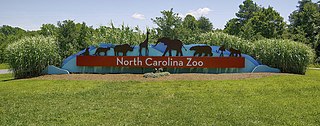
The North Carolina Zoo is a zoo in Asheboro, North Carolina, housing 1,800 animals of more than 250 species, primarily representing Africa and North America. It is one of two state-supported zoos in the United States, with the other being the Minnesota Zoo. With 500 acres (2.0 km2) developed, it is the world's largest natural habitat zoo. The North Carolina Zoo is a part of the North Carolina Department of Natural and Cultural Resources.

The San Francisco Zoo is a 100-acre (40 ha) zoo located in the southwestern corner of San Francisco, California, between Lake Merced and the Pacific Ocean along the Great Highway. The SF Zoo is a public institution, managed by the non-profit San Francisco Zoological Society, a 501(c)(3) organization. As of 2016, the zoo housed more than one thousand individual animals, representing more than 250 species. It is noted as the birthplace of Koko the gorilla, and, since 1974, the home of Elly, the oldest black rhinoceros in North America.
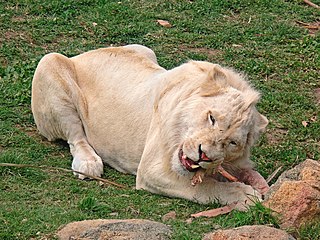
The white lion is a rare color mutation of the lion, specifically the Southern African lion. White lions in the area of Timbavati are thought to have been indigenous to the Timbavati region of South Africa for centuries, although the earliest recorded sighting in this region was in 1938. White lions first became known to the English-speaking world in 1977 through the book The White Lions of Timbavati.

Auckland Zoo is a 16.35-hectare (40-acre) zoological garden in Auckland, New Zealand, situated next to Western Springs park not far from Auckland's central business district. It is run by the Auckland Council with the Zoological Society of Auckland as a supporting organisation.

Zoológico Guadalajara is the main zoological park in the Mexican city of Guadalajara, Jalisco, and is widely considered the most important in Latin America. It is the largest in the country with respect to species population.
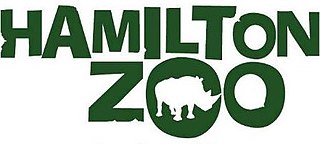
Hamilton Zoo is the main zoological garden of Hamilton, New Zealand. Covering 25 hectares, it is situated on Brymer Road in the Hamilton suburb of Rotokauri, on the outskirts of the metropolitan area towards the northwest. It is owned by the Hamilton City Council with the Department of Recreation and Welfare handling the day-to-day running of the site.
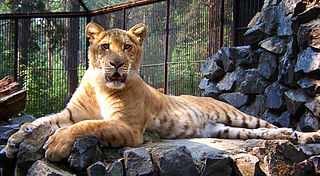
The Novosibirsk Zoo named after Rostislav Alexandrovich Shilo is a scientific institution as well as a popular tourist attraction. The zoo has around 11,000 animals representing 738 species and is an active participant in thirty-two different captive breeding programmes for endangered species. On average, over 1,500,000 people visit the zoo each year.

Tygerberg Nature Reserve is a 300-hectare (740-acre) nature reserve on the Tygerberg Hills in the northern suburbs of Cape Town, South Africa.
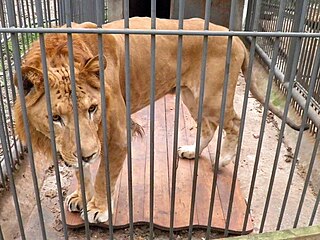
The liliger is the hybrid offspring of a male lion and a female liger. In accordance with Haldane's rule, male tigons and ligers are sterile, but female ligers and tigons can produce cubs. The first such hybrid was born in 1943, at the Hellabrunn Zoo.

The Groote Schuur Zoo was a 2-hectare (4.9-acre) zoo in Cape Town, South Africa. Established in 1931 at the request of deceased Cecil Rhodes, it was free of charge and a very popular attraction in Cape Town until its closure sometime between 1975 and 1985. The zoo shut down due to a combination of the financial burden that the Apartheid government faced and an increase in animal welfare standards. During its operation, it housed many animals including lions, emus, crocodiles and tahrs. The zoo can still be visited today, as it has been abandoned and left open to the public. The most prominent feature of the zoo is the Lion's Den, both when it was open and today where it still stands, full of overgrown vegetation.
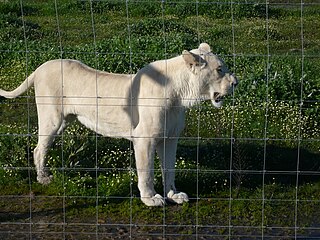
Drakenstein Lion Park is a zoological park in Drakenstein, Western Cape, South Africa. It was established in 1998 to keep lions which could not be rehabilitated into the wilderness, and was meant to replace the now-defunct Tygerberg Zoo, which housed possible descendants of the Cape lion, amongst other animals. Other animals included chimpanzees and tigers, including from Novosibirsk Zoo, from where Tygerberg's director John Spence managed to obtain his lions.
Knaresborough Zoo was a zoo located in the grounds of Conyngham Hall, Knaresborough, a small market town within the district of Harrogate, North Yorkshire. It opened on 29 July 1965 and closed on 13 January 1986.
